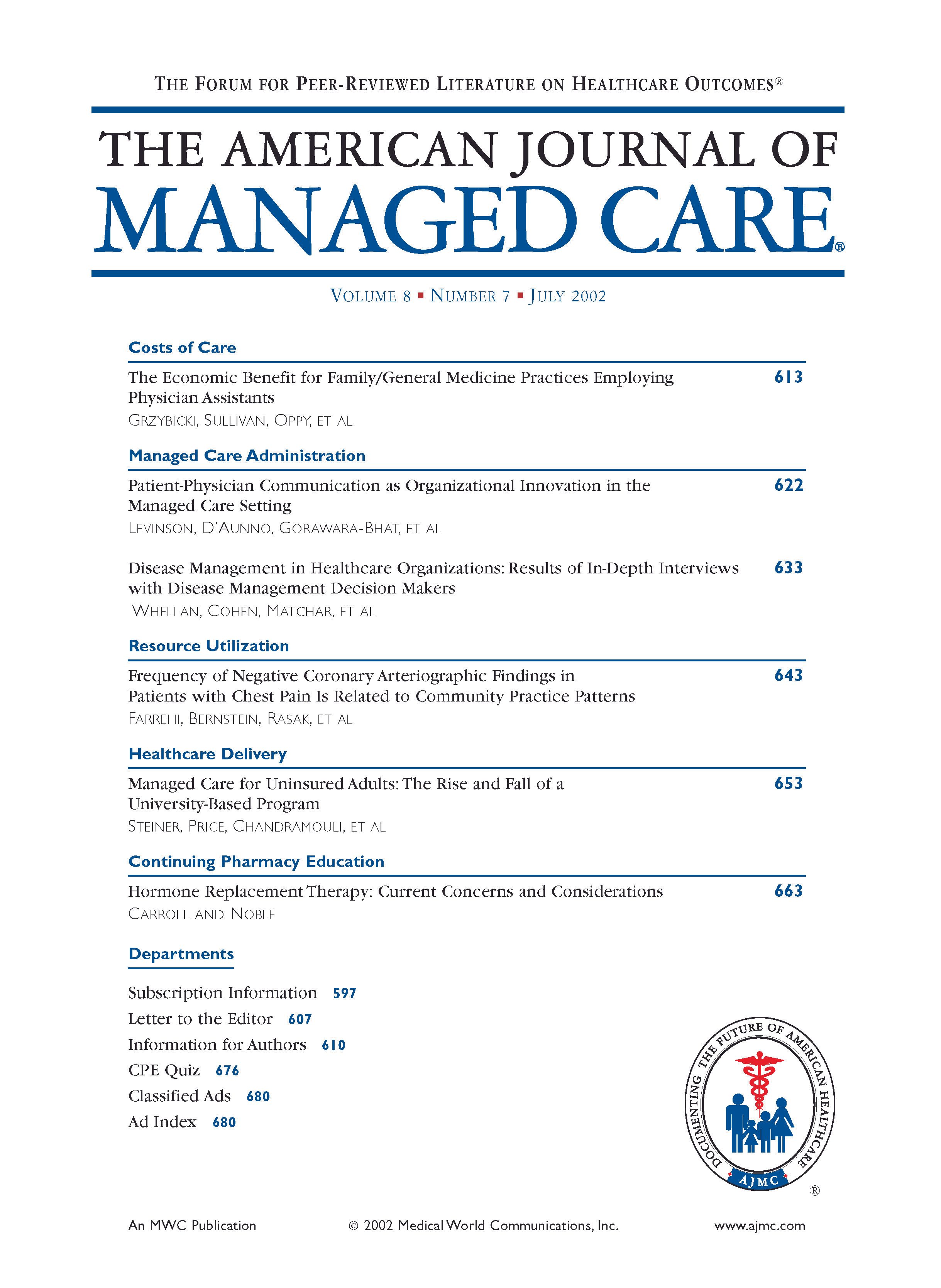Publication
Article
The American Journal of Managed Care
Using Guidelines to Improve Care of Patients With Chronic Kidney Disease
Author(s):
The National Kidney Foundation has establishedguidelines of care for patients both with end-stagerenal disease and those with chronic kidney disease.The initial guidelines for the dialysis population,created over a decade ago, were titled "DialysisOutcomes Quality Initiative." Within the last 3 years, thefoundation sought to develop guidelines for those withchronic kidney disease. These new guidelines are titled"Kidney Disease Outcomes Quality Initiative" (K/DOQI).
I am a member of the National Kidney FoundationMedical Advisory Board, which developed both of theseguidelines, and therefore I have a conflict of interest inwriting this editorial. We wrote multiple drafts of theguidelines, which were reviewed on many occasions.During 2-day face-to-face meetings we hammered outvarying approaches, and we reached consensus opinionin a democratic process before the Medical AdvisoryBoard signed off on the final product.
Journal
The article in this issue of the by Thorpaddresses "strategies to utilize chronic kidney diseaseguidelines in managed care organizations."1 While this islaudable for reasons of both improving care and controllingcosts, it is unclear whether managed care organizationsare equipped to implement the guidelines. Forexample, I only recently received from a health maintenanceorganization (HMO) a 2-page patient educationpamphlet about prevention of coronary artery diseasevia a program of cholesterol control and exercise. Therewas a major emphasis on diet/nutrition. Empoweringthe patient through education will have the greatest likelihoodfor long-term success in the area emphasized. Thisstep by the HMO is to be applauded and hopefully morepatient education pamphlets will follow (and then be reinforcedwith follow-up education pieces). Implementingguidelines, however, is an even more complex matter, andoutcome questions always need to be raised.
At the most basic level, we need to ask whether theinitial Dialysis Outcomes Quality Initiative guidelineshave a documented track record for improving care?Does the subsequent K/DOQI offer the same opportunityfor improving quality care and does implementationappear to be a cost-benefit positive move? This remainsthe major question.
For HMOs, having access to guidelines is one thing,implementing them is something entirely different.Implementation requires adapting the mindset of"spending $5.00 to save $10.00," and HMOs must firstinvest in systems of care and personnel in order toachieve the desired outcomes. Horizontal integration ofthe staff (physician, nurse, social worker, dietitian, rehabilitationspecialist, receptionist, etc) working togetheris a better model than a vertical, hierarchal arrangement.Defined responsibilities among members of thecare team offer the opportunity to achieve positiveresults when considering outcome results. Dictates from"above" can lead to inefficiency because this approachtends to stifle creativity. Therefore, HMOs must be willingto invest in personnel who can impact patient care,especially early in the course of the disease.
Based on the current number of practicing nephrologistsin the United States, the workforce levels are inadequateto handle the influx of patients with stages 1-5kidney disease who would be referred if primary carephysicians adhere to recommended K/DOQI guidelines.Therefore, more nurse practitioners and physician assistantswill need to be employed as part of the nephrologycare team so that early chronic kidney disease managementissues can be appropriately addressed.
Communication among all these caregivers is critical,and information technology is the necessary link foreffective communication and provides the potential foradditional levels of safety checks. For example, physicianorder entry systems employed at Beth IsraelDeaconess Medical Center, Boston, have reduced errorssubstantially and resulted in improved patient care.Every physician order is entered via the computer. Whenordering any test in the hospital, a computer entry detailspatient identification, reasons for ordering the test, and abrief background history. Interpretation of tests and studiesis made much easier with a history noted. When thepatient's insurer is an HMO, then the physician isprompted if prior approval is needed for any test (thedetails of Health Insurance Portability and AccountabilityAct compliance can be satisfied with safeguards). Suchcommunication links will reduce the unnecessary (andoften prolonged) phone approval from the HMO that cannegatively impact care. This is particularly important inthe outpatient setting. Another positive step at my institutionis pharmacy unit dosing, which again requirescomputer entry of all requested medications. Patient-physiciane-mail capability is another means to enhancecommunication, provided there are safeguards in place toprevent abuse of this type of interaction.
In addition, education of both patient and physicianis critical for any system to work. Empowering thepatient to be a full participant in his/her care is the criticalstep to achieve the best outcome results.
K/DOQI guidelines have established criteria fordefining 5 stages of chronic kidney disease. Estimatedglomerular filtration rate (eGFR) for patients withestablished chronic kidney disease can be assessedwith the equation derived from the Modification of Dietin Renal Disease study. Estimated glomerular filtrationrate requires knowing an individual's serum creatininelevel, gender, age, and race; 24-hour urine collectionsto determine creatinine clearances will no longer benecessary. Essentially, the eGRF will be a "freebie"every time the serum creatinine is measured. Thegreatest degree of inaccuracy is in those individualswith normal or near-normal renal function. However,this is not the population at greatest risk. The NationalKidney Foundation and the National Institutes ofHealth have both urged all laboratories to report eGFReach time they do a serum creatinine test. National laboratorieswill soon have this function available. Thislevel of reporting, done across the country, will allowfor a uniform approach to care, based on an understandingof the level of kidney function. Within severalyears, patients will know their eGFR in the same waythey know their blood pressure or cholesterol level.
Patients who understand their laboratory values andthe implications of those values derive the best outcomesfrom care (based on compliance with the prescribedregimen). Furthermore, patients should benotified of their laboratory results at the same time thephysician obtains the information. A patient who knowshis/her "numbers" will drive change in the care system,pushing their physicians to do the right thing. Therefore,HMOs must be committed to a vigorous and sustainedpatient education program.
Educational programs have already demonstratedimproved outcomes in smoking cessation.2-4 In addition,the creation of the Robert Wood Johnson FoundationAddressing Tobacco in Managed Care program mayoffer a model for other disease states. This program hasraised the general level of awareness of the problem, fosteredadditional research in the field, and enhancedpatient education efforts. Patient education and diseasemanagement for asthma has also become an importantissue for managed care programs.5
I am heartened to see Thorp raise the issue aboutimproving the care delivered to patients with chronickidney disease in a managed care setting. The costsincurred and impact on quality of life are immensewhen a patient deteriorates to end-stage renal disease.It is in everyone's interest to prevent or slow this progressionof disease. The devil of this improved care schemeis in the details, and we all wait to see the outcomes.
From the Renal Division, Beth Israel Deaconess Medical Center and Harvard MedicalSchool, Boston, Mass.
Address correspondence to: Theodore I. Steinman, MD, Beth Israel Deaconess MedicalCenter, Renal Division (ST 220), 330 Brookline Avenue, Boston, MA 02215.
Am J Manag Care
1. Thorp ML. Strategies to utilize chronic kidney disease guidelines in managedcare organizations. . 2004;10(7):417-422.
Prev Med
2. Curry SJ, Hollis J, Bush T, et al. A randomized trial of a family-based smokingprevention intervention in managed care. . 2003 Dec;37(6 Pt 1):617-626.
Health Promot Pract
3. Valanis B, Labuhn KT, Stevens NH, Lichtenstein E, Brody KK. Integrating prenatal-postnatal smoking interventions into usual care in a health maintenance organization. . 2003 Jul;4(3):236-248.
Am J ManagCare
4. Marcy TW, Thabault P, Olson J, Tooze JA, Liberty B, Nolan S. Smoking statusidentification: two managed care organizations' experiences with a pilot project toimplement identification systems in independent practice associations. . 2003 Oct;9(10):672-676.
J Asthma
5. Brugge D, Bagley J, Hyde J. Environmental management of asthma at toprankedUS managed care organizations. . 2003 Sep;40(6):605-614.




